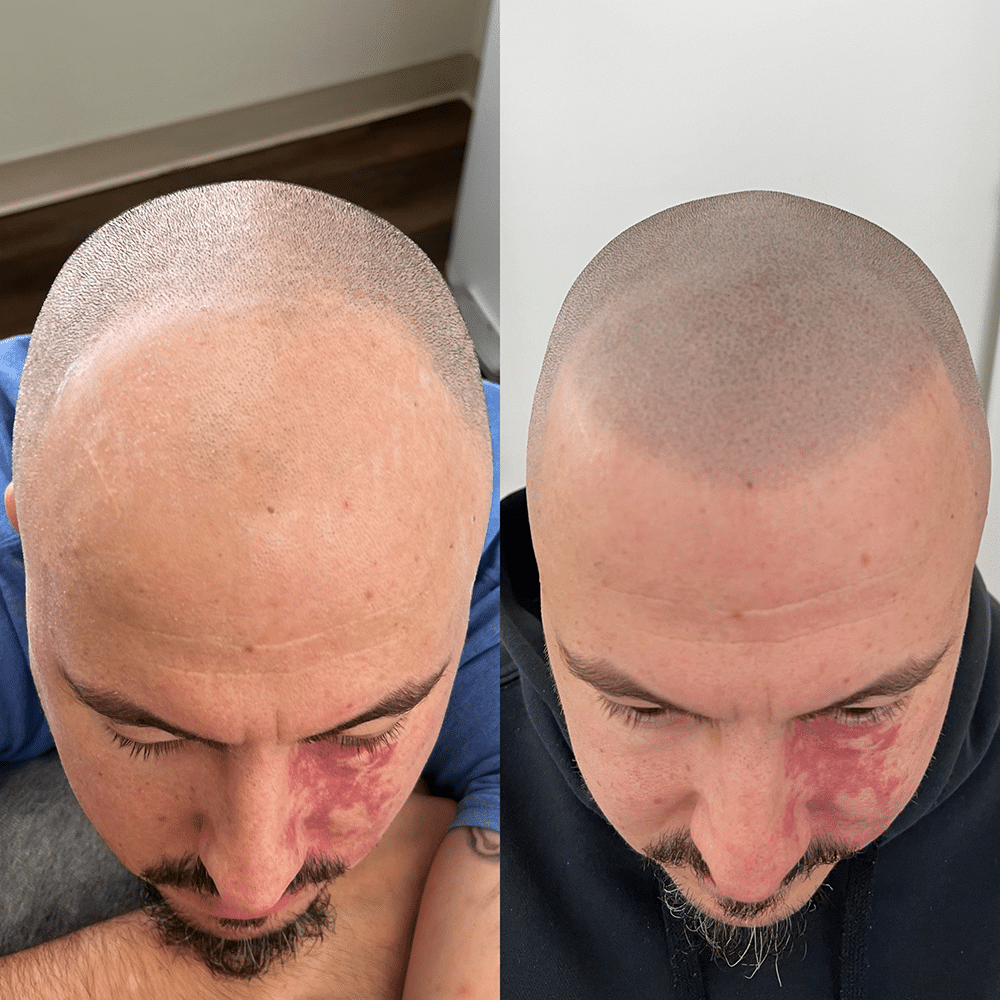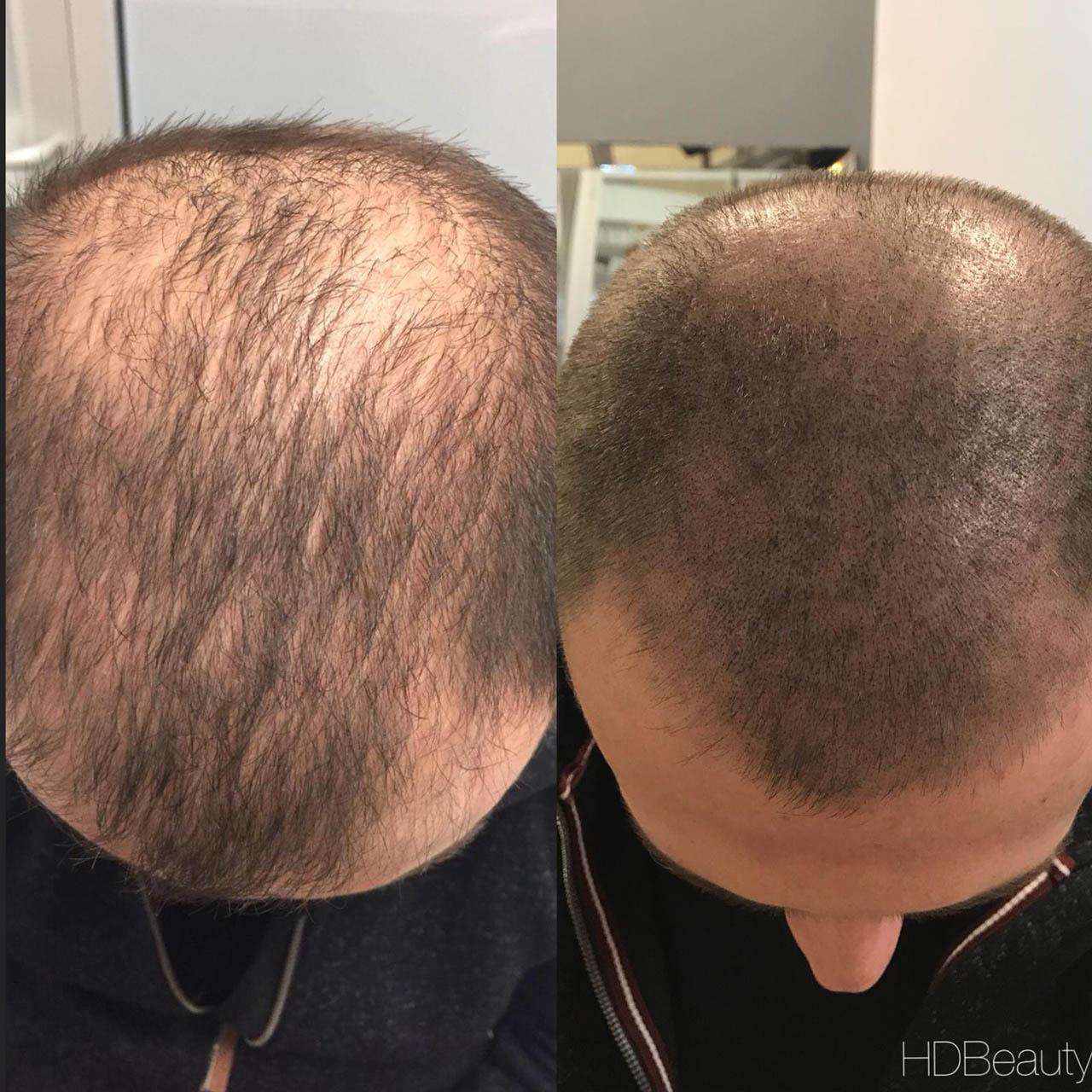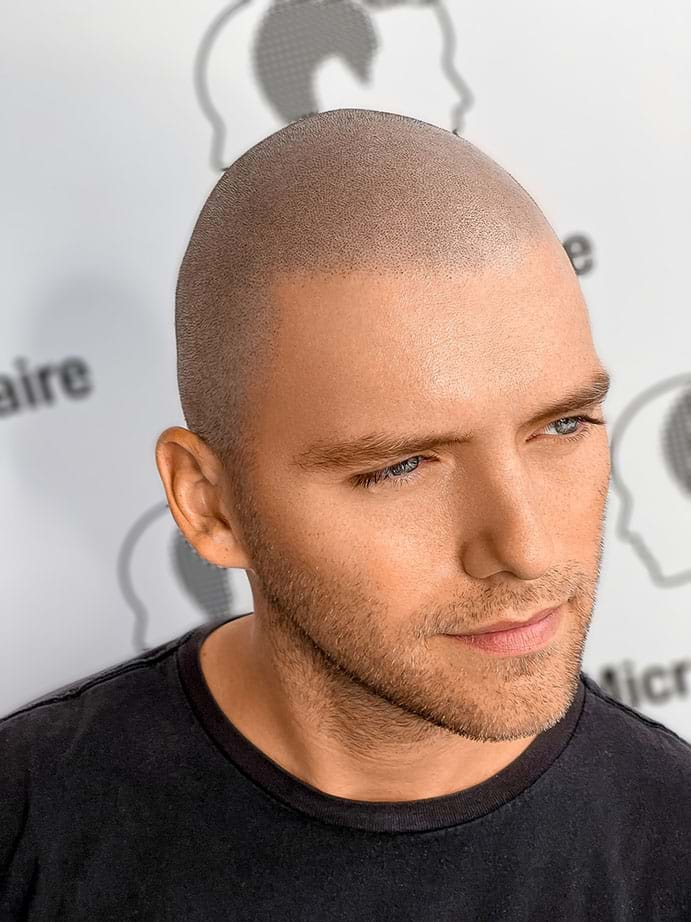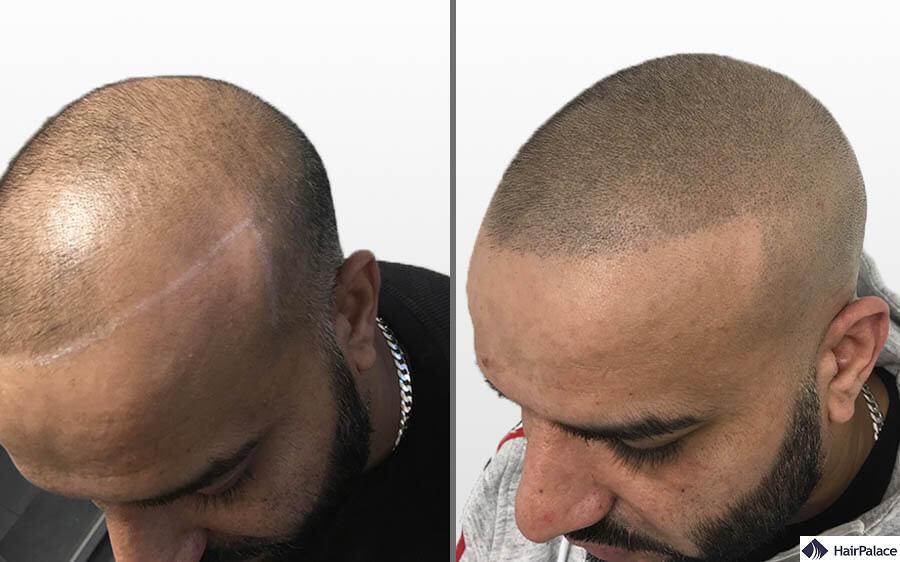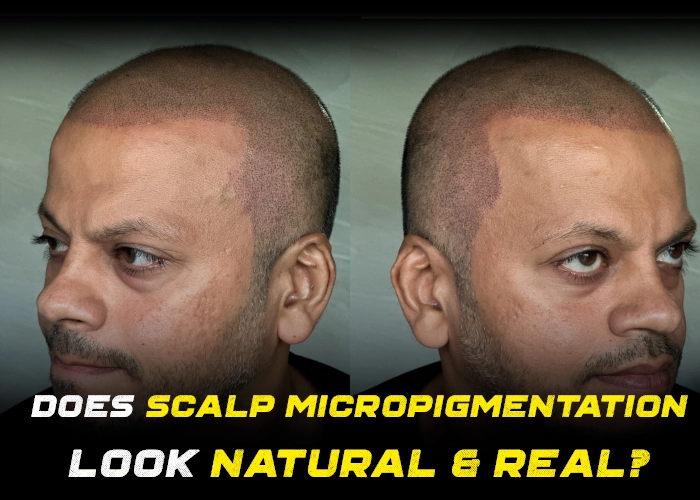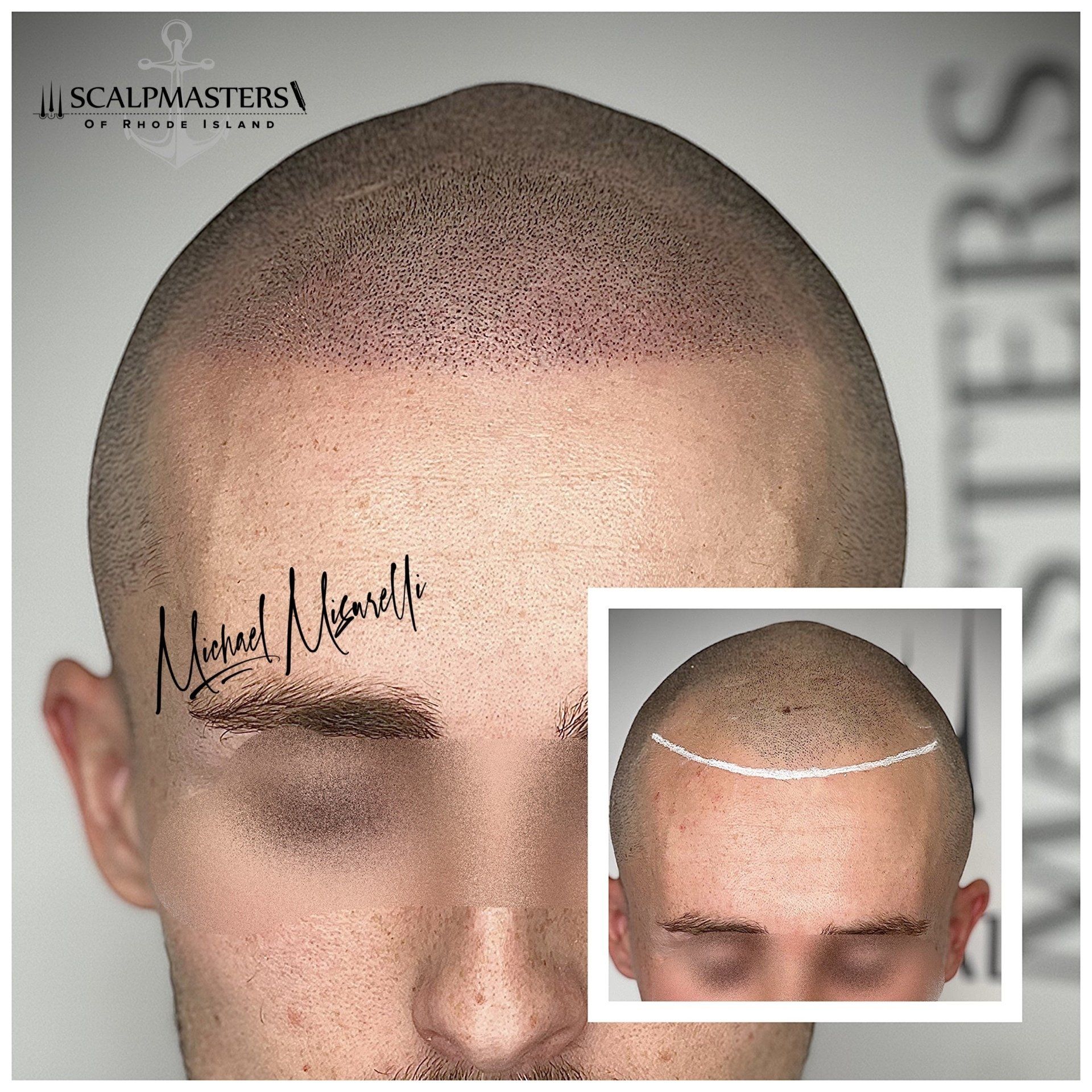25 Hair Tattoo Options That Will Transform Your Look (Complete Guide)
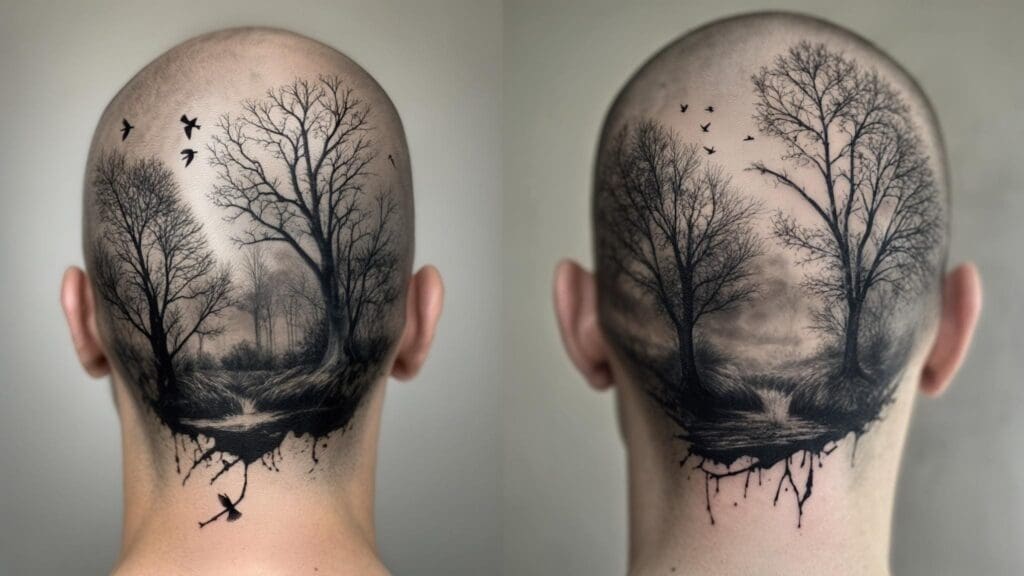
Recent studies show that 100% of patients who received scalp micropigmentation would recommend the procedure to others facing similar hair loss challenges. I remember when my friend Jake first told me about his hair tattoo consultation – he was skeptical but desperate after years of trying different hair loss treatments. Six months later, his confidence had completely transformed, and you couldn’t tell he’d ever struggled with balding. This remarkable satisfaction rate reflects the growing acceptance and effectiveness of hair tattoos as a viable solution for various hair-related concerns.
Source: Wimpole Clinic Hair Tattoo Study
Source: edgescalpink.com
Table of Contents
- Essential Factors Before Getting Your Hair Tattoo
- 1. Natural Hairline Reconstruction
- 2. Receding Hairline Fill-In
- 3. Widow’s Peak Creation
- 4. Temple Point Restoration
- 5. Juvenile Hairline Recreation
- 6. Asymmetrical Hairline Correction
- 7. Scar Camouflage Hairline
- 8. Soft Hairline Technique
- 9. Full Crown Restoration
- 10. Crown Density Enhancement
- 11. Vertex Point Definition
- 12. Crown-to-Nape Blending
- 13. Circular Crown Pattern
- 14. Crown Scar Integration
- 15. Graduated Crown Density
- 16. Surgical Scar Camouflage
- 17. Alopecia Pattern Coverage
- 18. Burn Scar Restoration
- 19. Medical Condition Camouflage
- 20. Birthmark Integration
- 21. Buzz Cut Simulation
- 22. Textured Scalp Design
- 23. Custom Pattern Creation
- 24. SMP with Hair Transplant Integration
- 25. Temporary-to-Permanent Progression
- Visualizing Your Perfect Hair Tattoo Design
- Final Thoughts
TL;DR
- Hair tattoos (scalp micropigmentation) offer 25 distinct options ranging from simple buzz cut simulations to complex hairline reconstructions
- Success depends on six critical factors: skin compatibility, hair loss pattern, maintenance commitment, practitioner expertise, realistic expectations, and budget considerations
- Buzz cut simulation provides the best value with universal skin compatibility and 4-6 year maintenance intervals
- Natural hairline reconstruction delivers the most realistic results but requires premium investment and expert practitioners
- Crown coverage options address the most visible hair loss areas with techniques ranging from density enhancement to full restoration
- Specialized scar camouflage techniques can effectively conceal surgical scars, burns, and medical condition-related hair loss
- Combination treatments like SMP with hair transplants maximize coverage but require coordinated care from multiple specialists
- Proper aftercare and sun protection extend results, with most options lasting 2-7 years before requiring touch-ups
Essential Factors Before Getting Your Hair Tattoo
Before diving into the 25 hair tattoo options, you need to evaluate six fundamental considerations that will determine your satisfaction with the results. Your skin type affects pigment retention and color matching requirements for scalp micropigmentation procedures. Your specific hair loss pattern dictates which micropigmentation techniques will work best for your situation.
Maintenance commitment varies significantly between options, with some requiring touch-ups every 2-3 years while others last 5-7 years. Practitioner expertise directly impacts the natural appearance and longevity of your hair tattoo results. Setting realistic expectations prevents disappointment and ensures you choose appropriate micropigmentation techniques. Finally, understanding the total cost including maintenance helps you make an informed financial decision about your hair tattoo investment.
Source: jaudonsunde.com
| Factor | Impact Level | Key Considerations | Decision Weight |
|---|---|---|---|
| Skin Type & Tone | High | Pigment retention, color matching, healing response | 25% |
| Hair Loss Pattern | Critical | Coverage area, technique selection, realistic outcomes | 30% |
| Maintenance Commitment | Medium | Touch-up frequency, sun protection, lifestyle changes | 15% |
| Practitioner Expertise | Critical | Portfolio quality, certification, specialized training | 25% |
| Budget Planning | Medium | Initial cost, maintenance expenses, value comparison | 10% |
| Realistic Expectations | High | Achievable outcomes, limitation understanding, satisfaction | 20% |
Skin tone analysis determines pigment formulation requirements, with darker complexions needing specialized color matching techniques and different needle approaches compared to lighter skin tones. Hair loss severity assessment guides technique selection, as complete baldness requires different coverage strategies than partial thinning or receding hairlines, affecting both treatment complexity and final appearance expectations.
Skin Type and Tone Compatibility
Your natural skin tone and texture determine which pigment formulations will work best and how the final results will appear. Darker skin requires different approaches compared to lighter complexions, with practitioners needing to match pigments precisely to your hair color and skin undertones. The compatibility between your skin characteristics and chosen technique affects both immediate results and long-term appearance as the micropigmentation ages.
Understanding the investment required for scalp micropigmentation is crucial, especially when considering different skin types. Our comprehensive tattoo cost guide covers the various factors that influence pricing across different complexions and treatment areas.
Pigment chemistry varies significantly between skin tones, requiring specialized formulations that account for undertone variations and natural melanin levels. Skin texture assessment determines needle depth requirements and healing expectations, as different skin types retain pigments differently and may require modified techniques.
Hair Loss Pattern and Severity
Understanding your specific hair loss pattern helps determine which of the 25 techniques will be most effective for your situation. Complete baldness requires different strategies than receding hairlines or crown thinning. Your pattern also influences the complexity of treatment needed and realistic expectations for coverage. Progressive conditions may require techniques that accommodate future changes.
Case Study: Michael’s Pattern Assessment
Michael, a 34-year-old marketing executive, presented with Norwood Stage 4 hair loss – significant recession at temples with crown thinning beginning. Rather than full crown restoration, his practitioner recommended receding hairline fill-in combined with crown density enhancement. This targeted approach addressed his most visible concerns while preserving his remaining hair, resulting in natural-looking coverage that aged gracefully over the following three years.
Pattern analysis includes assessment of current loss extent, progression rate, and family history to predict future changes that could affect treatment longevity. Severity classification determines whether enhancement techniques will suffice or if complete reconstruction approaches are necessary for satisfactory hair tattoo results. Scalp micropigmentation success depends heavily on matching the right technique to your specific pattern and severity level.
Lifestyle and Maintenance Requirements
Different hair tattoo options demand varying maintenance commitments, from touch-ups every 2-3 years to intervals of 5-7 years. Your lifestyle factors such as sun exposure, physical activity, and grooming preferences influence which techniques will work best. Budget planning must include ongoing maintenance costs, not just initial treatment expenses. Some people prefer lower-maintenance options even if they sacrifice some aesthetic advantages.
Maintenance scheduling varies based on technique complexity, sun exposure levels, and individual skin characteristics that affect pigment retention rates. Lifestyle compatibility assessment includes evaluation of daily routines, grooming habits, and long-term commitment capacity for ongoing care requirements. Micropigmentation results require consistent aftercare to maintain their appearance and longevity.
Practitioner Expertise and Certification
The skill level of your micropigmentation specialist represents perhaps the most critical success factor across all 25 options. Certified practitioners with extensive portfolios, proper training credentials, and positive reviews deliver consistently better results. Equipment quality, pigment standards, and hygiene practices must meet industry best practices. Some techniques require specialized training beyond basic scalp micropigmentation certification.
Source: hdpermanentmakeup.ca
Certification verification includes checking training credentials, continuing education requirements, and specialization in specific techniques relevant to your needs. Portfolio assessment should include examples of work similar to your desired outcome, with attention to natural appearance and long-term results documentation.
Realistic Expectations and Desired Outcome
Understanding what micropigmentation can and cannot achieve prevents disappointment and helps you select appropriate techniques. While creating convincing hair follicle illusions, these treatments don’t provide actual hair growth. Setting proper expectations about healing processes, final appearance, and limitations ensures satisfaction with results. Some techniques deliver more dramatic changes than others.
Expectation management requires clear communication about achievable outcomes versus desired results, with honest assessment of technique limitations. Outcome visualization helps align expectations with reality through examples of similar cases and discussion of potential complications or suboptimal results. Your hair tattoo success depends on realistic goal setting from the beginning.
Cost and Value Proposition
Hair tattoos represent significant investments with costs varying based on complexity, location, and practitioner expertise. Long-term value comparisons with ongoing hair loss treatments or transplant procedures help justify expenses. Total cost calculations must include maintenance, touch-ups, and potential revision work. Some techniques offer better value propositions than others depending on your specific needs.
Cost analysis includes initial treatment expenses, ongoing maintenance requirements, and potential additional procedures needed for optimal results. Value assessment compares total lifetime costs against alternative treatments while considering satisfaction rates and longevity of different approaches. Scalp micropigmentation represents a long-term investment in your appearance and confidence.
1. Natural Hairline Reconstruction
Natural hairline reconstruction represents the most sophisticated hair tattoo technique, completely recreating a realistic hairline tattoo using varying dot sizes and densities. This comprehensive approach requires 3-4 sessions over several months, with each session building layers of complexity. The process involves detailed facial analysis, custom pigment blending, and strategic density mapping to achieve results that appear completely natural.
While requiring the highest investment and most skilled practitioners, this option delivers the most dramatic transformation for those with complete frontal hair loss. Advanced practitioners use multiple needle configurations and 3-5 different pigment shades to create natural variation, requiring 12-20 hours of total treatment time across progressive sessions. Success depends on precise hairline mapping that follows natural growth patterns and facial proportions, with irregular organic shapes that avoid obvious artificial lines or geometric patterns.
Source: microbladingla.com
The scalp micropigmentation process for natural hairline reconstruction demands exceptional artistic skill and technical precision. Each dot must be placed with consideration for natural hair growth direction, density variation, and color gradation to achieve convincing results.
2. Receding Hairline Fill-In
Receding hairline fill-in targets specific areas where your hairline has pulled back, blending seamlessly with existing hair to restore a fuller appearance. This technique works exceptionally well for early to moderate recession, offering excellent value through targeted treatment of smaller areas. The process requires moderate practitioner skill focused on blending techniques rather than complete reconstruction.
Results appear virtually undetectable when properly executed, with lower maintenance requirements and mid-range pricing making this option accessible to many people. Blending existing hair with micropigmentation requires precise color matching and strategic dot placement to avoid obvious transitions between natural and tattooed areas.
Treatment success relies on accurate assessment of recession patterns and future hair loss progression to ensure long-term satisfaction with hairline positioning. Your hairline tattoo should complement your existing hair while accounting for potential future changes. This hair tattoo technique offers one of the best value propositions for people with moderate recession patterns.
3. Widow’s Peak Creation
Widow’s peak creation adds character and definition to your hairline by forming the distinctive V-shaped point in the center of your forehead. This technique can enhance existing subtle peaks or create entirely new ones for those who want this classic masculine feature. The process requires careful geometric planning and understanding of facial proportions to ensure the peak appears natural and age-appropriate.
Often combined with overall hairline enhancement, this option works well for people seeking to add distinctive character to their appearance. Peak formation requires precise angle calculations and symmetrical design to create natural-looking points that complement facial structure and existing hair patterns. Successful widow’s peak creation balances prominence with subtlety, avoiding overly dramatic points that appear artificial while ensuring sufficient definition to achieve the desired aesthetic effect.
Hair tattoo specialists must consider your facial structure and existing hairline when creating widow’s peaks. The micropigmentation technique requires artistic judgment to achieve the right balance between definition and natural appearance.
4. Temple Point Restoration
Temple point restoration focuses specifically on recreating the natural points that frame your face at the temples, providing a more youthful and defined appearance. These areas often recede first in male pattern baldness, making their restoration particularly impactful for facial framing. The temple area typically has consistent skin texture, making it excellent for micropigmentation with moderate maintenance requirements.
This technique requires high precision for natural angle creation but offers dramatic improvement in facial symmetry and youthful appearance. Temple restoration requires understanding of natural hair growth angles and directional patterns specific to these highly visible facial framing areas.
Source: eugenixhairsciences.com
Success depends on creating points that appear naturally integrated with existing hair while accounting for continued hair loss progression in surrounding areas. Your hair tattoo specialist must balance immediate aesthetic improvement with long-term appearance considerations. Micropigmentation in the temple area requires careful attention to natural growth patterns and facial proportions.
5. Juvenile Hairline Recreation
Juvenile hairline recreation attempts to restore the straighter, lower hairline characteristic of younger individuals. This technique requires extremely careful consideration to ensure age-appropriate results, as overly youthful hairlines can appear unnatural on mature faces. The process demands advanced aesthetic judgment from practitioners who must balance the desire for a youthful appearance with realistic expectations.
While offering dramatic rejuvenation potential, this option carries higher risk of unrealistic results if not properly planned and executed. Age-appropriate hairline positioning requires analysis of facial maturity, existing features, and natural aging patterns to avoid creating unrealistic youthful appearances. Pigment selection must account for potential future graying of surrounding hair to maintain long-term natural appearance as the client ages.
Your hairline tattoo should complement your current age and facial characteristics rather than attempting to recreate a teenage appearance. Scalp micropigmentation specialists must exercise careful judgment when considering juvenile hairline recreation requests.
6. Asymmetrical Hairline Correction
Asymmetrical hairline correction addresses uneven or irregular hairlines caused by genetics, trauma, or uneven hair loss patterns. This technique creates balance and symmetry through strategic micropigmentation placement, often requiring custom design work to accommodate existing skull shape irregularities. The process demands advanced measurement and design skills from practitioners who must work with natural asymmetries rather than against them.
Results provide significant improvement in facial symmetry, though complete perfection may not always be achievable. Correction techniques must work with existing skull contours and facial asymmetries, using optical illusions and strategic shading to create perceived symmetry. Success requires detailed mapping of existing irregularities and careful planning to ensure corrections appear natural rather than obviously artificial or geometric.
Hair tattoo specialists approach asymmetrical correction by analyzing your unique facial structure and developing customized solutions. Micropigmentation can significantly improve symmetry while working within the constraints of your natural features.
7. Scar Camouflage Hairline
Scar camouflage hairline technique specifically conceals scars within the hairline area from accidents, previous surgeries, or medical conditions. This specialized approach requires assessment of scar tissue characteristics and healing capacity before treatment. The process often involves modified techniques to accommodate irregular skin texture and altered pigment retention in scarred areas.
While significant improvement is typically achievable, complete invisibility may not always be possible depending on scar severity and characteristics. Scar tissue assessment includes evaluation of texture, elasticity, and pigment retention capacity to determine treatment feasibility and expected outcomes. Modified micropigmentation techniques accommodate irregular skin surfaces and potential pigment migration issues specific to scarred tissue healing patterns.
Scalp micropigmentation for scar camouflage requires specialized expertise and realistic expectations about achievable results. Your hair tattoo specialist must evaluate each scar individually to determine the best approach for concealment.
8. Soft Hairline Technique
Soft hairline technique creates a subtle, graduated hairline that appears naturally soft and realistic by avoiding harsh lines or obvious demarcation. This approach uses gradual density changes and varied dot sizes to create organic transitions that mimic natural hair growth patterns. The technique works particularly well for people who want enhancement without obvious artificial appearance.
Results tend to age gracefully as gradual fading appears more natural than sharp line deterioration. Graduated density application uses progressively lighter pigment concentrations and increased dot spacing toward hairline edges to create natural softness. Soft transition techniques require advanced understanding of natural hair growth patterns and optical effects to achieve realistic graduated appearances.
Hair tattoo specialists use this micropigmentation approach when clients prioritize natural appearance over dramatic definition. The technique requires artistic skill to create convincing gradual transitions that appear completely organic.
9. Full Crown Restoration
Full crown restoration provides comprehensive scalp tattoo coverage for the entire crown area, creating the appearance of a full head of hair when viewed from above. This extensive technique uses varying densities to mimic natural hair growth patterns across the curved scalp surface. The process requires high skill levels for natural density variation and careful attention to sun exposure effects.
While offering dramatic transformation for extensive crown baldness, this option requires regular maintenance due to the highly visible and sun-exposed treatment area. Crown coverage must accommodate natural scalp curvature and varying skin characteristics across the treatment area while maintaining consistent appearance from multiple viewing angles.
Source: hairpalace.co.uk
Density variation techniques create realistic hair growth patterns that avoid artificial uniformity while ensuring adequate coverage for the highly visible crown area. Your hair tattoo specialist must consider viewing angles, lighting conditions, and natural growth patterns when planning full crown restoration. Scalp micropigmentation in this area requires exceptional skill due to the complex curvature and high visibility of the crown region.
10. Crown Density Enhancement
Crown density enhancement adds strategic micropigmentation between existing hair follicles to create a fuller appearance without complete coverage. This technique preserves and enhances your remaining hair while filling in thin areas for improved overall density. The process requires precise spacing calculations to avoid obvious artificial patterns while working around existing hair growth.
This option offers excellent value for people with moderate crown thinning who want to enhance rather than replace their natural hair. Strategic placement between existing follicles requires careful analysis of natural growth patterns and spacing to create seamless integration with remaining hair. Enhancement techniques must account for continued natural hair loss progression to ensure long-term satisfaction with density improvements.
Case Study: Sarah’s Crown Enhancement Success
Sarah, a 42-year-old teacher, noticed gradual crown thinning that became visible under classroom lighting. Rather than full crown restoration, her practitioner used density enhancement to strategically fill gaps between existing follicles. The treatment took two sessions, cost 40% less than full coverage, and provided natural-looking fullness that complemented her existing hair perfectly. Three years later, the enhancement still looks natural despite continued gradual thinning.
Hair tattoo specialists often recommend this approach for clients with moderate thinning who want to maximize their existing hair. Micropigmentation enhancement can significantly improve appearance while preserving natural hair and reducing treatment complexity.
11. Vertex Point Definition
Vertex point definition focuses on creating a natural-looking center point at the back of your head where hair growth patterns naturally converge. This subtle but important detail ensures realistic appearance from all angles, particularly when combined with other crown coverage techniques. The vertex area often has different skin characteristics that require specialized attention.
While seemingly minor, proper vertex definition is crucial for overall crown realism and natural appearance. Vertex point creation requires understanding of natural hair growth convergence patterns and how they vary between individuals based on head shape and genetics. Proper vertex definition serves as an anchor point for surrounding crown coverage, ensuring natural flow and realistic growth pattern simulation.
Scalp micropigmentation specialists pay careful attention to vertex point placement as it affects the overall natural appearance of crown treatments. Your hair tattoo results depend on these subtle details that create convincing realism. Micropigmentation in the vertex area requires precision and understanding of natural hair growth convergence patterns.
12. Crown-to-Nape Blending
Crown-to-nape blending creates seamless transitions from crown coverage down to the nape of your neck, ensuring natural appearance from all viewing angles. This technique addresses the often-overlooked back and lower areas that can reveal artificial appearance if not properly integrated. The process requires understanding of natural hair growth transitions and how they change across different scalp areas.
Proper blending prevents obvious demarcation lines that can compromise the overall natural effect. Transition blending requires gradual density changes and directional adjustments to match natural hair growth patterns as they flow from crown to nape areas. Successful integration accounts for different skin characteristics and hair growth directions across the posterior scalp region.
Hair tattoo specialists must consider the entire back of the head when planning crown treatments to ensure seamless integration. Scalp micropigmentation requires attention to these transition areas to maintain natural appearance from all angles.
13. Circular Crown Pattern
Circular crown pattern mimics the natural circular growth pattern of crown hair, which is essential for realistic results in this highly visible area. This technique requires advanced pattern recognition and recreation skills to achieve the subtle spiral or circular arrangements found in natural crown hair growth. The process involves careful planning of dot placement and directional flow to create convincing circular patterns.
This specialized approach is often combined with other crown techniques for comprehensive coverage. Natural crown patterns vary significantly between individuals, requiring customized circular or spiral designs based on existing growth patterns and head shape characteristics. Pattern recreation techniques must maintain consistent directional flow while accommodating the curved scalp surface and varying viewing angles.
Scalp micropigmentation specialists study natural crown patterns to recreate them convincingly through strategic dot placement. Your hair tattoo success depends on accurate pattern recreation that matches natural growth characteristics. Micropigmentation requires artistic skill to create believable circular crown patterns.
14. Crown Scar Integration
Crown scar integration specifically addresses scars or irregularities within the crown area, blending them seamlessly with surrounding micropigmentation coverage. This technique requires assessment of scar tissue characteristics and specialized approaches for irregular skin surfaces. The crown’s high visibility makes successful scar integration particularly important for overall treatment success.
While challenging due to altered skin properties in scarred areas, significant improvement is typically achievable with proper technique and realistic expectations. Scar integration requires modified needle techniques and potentially different pigment formulations to accommodate altered skin texture and healing characteristics. Success depends on careful assessment of scar maturity, texture, and pigment retention capacity before determining treatment approach and expected outcomes.
Scalp micropigmentation for crown scar integration demands specialized expertise and modified techniques. Your hair tattoo specialist must evaluate scar characteristics and develop customized approaches for optimal results. Micropigmentation can significantly improve the appearance of crown scars when properly executed.
15. Graduated Crown Density
Graduated crown density uses varying dot densities to create natural variation found in healthy crown hair growth, avoiding the artificial uniformity that can compromise realistic appearance. This technique requires advanced understanding of how natural hair density varies across the crown area and how to replicate these patterns through micropigmentation. The process involves strategic planning of density zones and gradual transitions between different coverage levels.
This approach significantly enhances the natural appearance of crown coverage. Natural density variation patterns require analysis of how hair thickness and spacing change across different crown zones to create realistic coverage gradients. Graduated techniques use varying dot sizes, spacing, and pigment concentrations to simulate the natural irregularities found in healthy hair growth patterns.
Hair tattoo specialists use graduated density to create more convincing crown coverage that mimics natural variation. Scalp micropigmentation benefits from this approach as it avoids the artificial uniformity that can reveal treatment. Micropigmentation with graduated density requires advanced technical skill and artistic judgment.
16. Surgical Scar Camouflage
Surgical scar camouflage represents the most advanced hair tattoo technique for concealing scars from hair transplant procedures, scalp surgeries, or accidents. This specialized approach requires extensive assessment of scar tissue healing and pigment retention capacity before treatment. The process involves modified techniques, specialized pigments, and extended healing periods between sessions.
While significant improvement is typically achievable, complete invisibility may not be possible depending on scar characteristics and severity. Scar tissue assessment includes evaluation of texture, elasticity, vascularity, and healing maturity to determine treatment feasibility and expected pigment retention rates. Specialized techniques accommodate irregular skin surfaces, altered healing responses, and potential complications specific to scarred tissue micropigmentation.
Source: skalptec.com
For those considering scar camouflage, understanding the financial commitment is essential. Different scar types and sizes affect pricing significantly, which is covered in detail in our comprehensive tattoo pricing guide that addresses various specialized techniques and their associated costs.
Scalp micropigmentation for surgical scar camouflage requires the highest level of expertise and specialized training. Your hair tattoo specialist must have extensive experience with scar tissue to achieve optimal results. Micropigmentation can dramatically improve the appearance of surgical scars when performed by qualified practitioners.
17. Alopecia Pattern Coverage
Alopecia pattern coverage addresses various forms of alopecia through customized micropigmentation approaches designed for patchy or total hair loss patterns. This technique requires understanding of different alopecia types and their characteristic patterns to create appropriate coverage strategies. The process must accommodate potentially changing hair loss patterns and varying skin sensitivity associated with autoimmune conditions.
Treatment success depends on realistic expectations and understanding of the condition’s progressive nature. Alopecia coverage strategies must account for different condition types, progression patterns, and potential for continued hair loss in treated and untreated areas. Treatment planning requires coordination with medical professionals managing the underlying condition to ensure appropriate timing and realistic outcome expectations.
Scalp micropigmentation for alopecia requires specialized knowledge of autoimmune hair loss conditions. Your hair tattoo specialist should work closely with your medical team to develop appropriate treatment plans. Micropigmentation can provide significant psychological and aesthetic benefits for people with alopecia when properly planned and executed.
18. Burn Scar Restoration
Burn scar restoration addresses scalp areas affected by burns through highly specialized micropigmentation techniques designed for severely compromised skin. This complex procedure requires extensive assessment of tissue quality, healing capacity, and realistic outcome expectations. The process often involves multiple treatment phases and potential coordination with reconstructive procedures.
While challenging due to altered skin properties, this technique can provide significant psychological and aesthetic benefits for burn survivors. Burn scar assessment requires evaluation of tissue depth, elasticity, sensation, and healing capacity to determine treatment feasibility and safety considerations. Specialized techniques accommodate altered skin architecture, potential sensitivity issues, and modified healing responses specific to burn-damaged tissue.
Scalp micropigmentation for burn scar restoration represents one of the most challenging applications of hair tattoo techniques. Your specialist must have extensive experience with burn scar tissue to ensure safe and effective treatment. Micropigmentation can offer hope and improved appearance for burn survivors when performed by qualified experts.
19. Medical Condition Camouflage
Medical condition camouflage addresses hair loss from various medical treatments, conditions, or medications through customized micropigmentation approaches. This technique provides both psychological and aesthetic benefits for people dealing with medical hair loss. The process requires understanding of different medical conditions and their effects on skin and hair characteristics.
Treatment planning often involves coordination with healthcare providers to ensure appropriate timing and safety considerations. Medical condition assessment includes evaluation of underlying health status, medication effects, and potential treatment interactions that could affect micropigmentation outcomes. Specialized approaches accommodate varying skin sensitivity, healing capacity, and potential complications associated with different medical conditions and treatments.
Hair tattoo specialists working with medical condition camouflage must understand the unique challenges posed by various health conditions. Scalp micropigmentation can provide significant quality of life improvements for people experiencing medical hair loss. Micropigmentation requires careful coordination with medical teams to ensure safe and effective treatment.
20. Birthmark Integration
Birthmark integration incorporates natural birthmarks or skin variations into the overall micropigmentation design for seamless results rather than attempting to cover them completely. This technique requires color theory expertise and advanced blending skills to work harmoniously with existing pigmentation. The process involves careful assessment of birthmark characteristics and how they interact with micropigmentation pigments.
Success depends on realistic expectations about integration rather than complete camouflage. Integration techniques require analysis of birthmark pigmentation, texture, and stability to determine how micropigmentation will interact with existing skin variations. Color matching strategies accommodate existing pigmentation variations while creating cohesive overall appearance that incorporates rather than fights natural skin characteristics.
Micropigmentation specialists approach birthmark integration with artistic skill and technical expertise. Your hair tattoo results can successfully incorporate birthmarks when properly planned and executed. Micropigmentation works best when it embraces rather than attempts to completely conceal natural skin variations.
21. Buzz Cut Simulation
Buzz cut simulation creates the appearance of a freshly shaved head with visible hair follicles, representing one of the most straightforward yet effective hair tattoo options. This technique works exceptionally well across all skin tones and hair loss levels, providing immediate visual impact with relatively simple execution. The process involves creating thousands of uniform dots across the scalp using single-needle techniques.
With lower maintenance requirements and mid-range pricing, this option offers excellent value for people preferring a close-cropped appearance. Uniform dot placement requires consistent spacing and depth control to create the appearance of evenly distributed hair follicles across the entire scalp surface. Single-needle techniques focus on precision and consistency rather than artistic variation, making this option more accessible while still requiring proper training and equipment.
Source: mastertattooinstitute.com
Before committing to buzz cut simulation, exploring different design possibilities can help ensure you’re making the right choice. Our comprehensive guide to AI tattoo generators showcases cutting-edge tools that can help you preview different hair tattoo patterns and styles, making it easier to communicate your vision to micropigmentation specialists.
| Hair Tattoo Option | Complexity Level | Average Sessions | Maintenance Interval | Cost Range | Best For |
|---|---|---|---|---|---|
| Buzz Cut Simulation | Low | 2-3 | 4-6 years | $2,000-$4,000 | All hair loss levels |
| Receding Hairline Fill-In | Medium | 2-3 | 3-5 years | $1,500-$3,500 | Early-moderate recession |
| Crown Density Enhancement | Medium | 2-4 | 3-4 years | $2,500-$4,500 | Moderate crown thinning |
| Natural Hairline Reconstruction | High | 3-4 | 2-4 years | $4,000-$8,000 | Complete frontal loss |
| Full Crown Restoration | High | 3-5 | 2-3 years | $3,500-$7,000 | Extensive crown baldness |
| Surgical Scar Camouflage | Very High | 3-6 | 2-4 years | $3,000-$6,000 | Post-surgical scarring |
Scalp micropigmentation through buzz cut simulation provides consistent results across different skin types and hair loss patterns. Your hair tattoo specialist can achieve excellent results with this technique regardless of your specific characteristics. Micropigmentation using buzz cut simulation offers one of the best value propositions in the field.
22. Textured Scalp Design
Textured scalp design incorporates texture and variation to create a more dynamic, realistic appearance that mimics natural hair growth irregularities rather than artificial uniformity. This advanced technique requires artistic skill in creating natural-looking irregularities and variations in dot size, spacing, and depth. The process involves strategic planning of texture zones and how they interact to create overall realism.
While requiring premium pricing for advanced artistic techniques, this approach delivers superior realism compared to uniform methods. Texture creation techniques use varying needle approaches, dot sizes, and spacing patterns to simulate the natural irregularities found in real hair growth. Advanced artistic skills are required to create convincing texture variations while maintaining overall cohesive appearance and avoiding obvious artificial patterns.
Hair tattoo specialists with advanced artistic training excel at textured scalp design techniques. Micropigmentation with texture variation creates more convincing results that closely mimic natural hair characteristics. This approach represents the artistic pinnacle of scalp micropigmentation techniques.
23. Custom Pattern Creation
Custom pattern creation develops unique, personalized patterns based on your individual facial features, head shape, and personal preferences. This bespoke approach represents the luxury tier of hair tattoo services, requiring the highest level of artistic and technical skill. The process involves extensive consultation, digital design work, and multiple refinement phases to achieve completely personalized results.
While commanding premium pricing, this option delivers results tailored specifically to your unique characteristics and aesthetic goals. Custom design development requires advanced facial analysis, proportion calculations, and artistic interpretation to create patterns that complement individual features. Bespoke techniques combine multiple specialized approaches and require extensive practitioner experience to execute complex, personalized design elements successfully.
Source: micropigmentation.academy
Scalp micropigmentation through custom pattern creation represents the ultimate in personalized hair tattoo services. Your specialist must possess exceptional artistic and technical skills to create truly bespoke results. Micropigmentation at this level requires extensive experience and artistic vision to achieve completely customized outcomes.
24. SMP with Hair Transplant Integration
SMP with hair transplant integration combines scalp micropigmentation with existing or planned hair transplant procedures to maximize coverage and natural appearance. This complex approach requires coordination between SMP specialists and hair transplant surgeons to achieve optimal results. The process involves careful timing of procedures and specialized techniques that work harmoniously with both natural and transplanted hair.
While representing the highest cost category, this combination approach can deliver maximum natural appearance for suitable candidates. Integration planning requires coordination between multiple specialists to optimize timing, technique selection, and coverage strategies that complement both procedures. Combined maintenance protocols must account for different healing timelines, touch-up requirements, and long-term care needs for both transplanted hair and micropigmentation.
Case Study: David’s Combined Treatment Success
David, a 38-year-old architect, had a hair transplant that provided good frontal coverage but left his crown area sparse. Rather than another transplant, he chose SMP integration to fill the crown while enhancing transplant density. The combined approach required coordination between his surgeon and SMP specialist, with micropigmentation performed six months post-transplant. The result provided complete coverage that looked entirely natural, with the SMP seamlessly blending with transplanted and existing hair.
Hair tattoo integration with transplant procedures requires exceptional coordination and expertise from both specialists. Scalp micropigmentation can significantly enhance transplant results when properly integrated. Micropigmentation combined with transplant surgery offers the most comprehensive solution for extensive hair loss when budget allows.
25. Temporary-to-Permanent Progression
Temporary-to-permanent progression starts with temporary or semi-permanent options before committing to full permanent micropigmentation, allowing for adjustments and refinements based on initial results. This cautious approach helps ensure satisfaction with final results while providing opportunity to experience the treatment effects. The process involves multiple phases with increasing permanence and complexity.
While extending the overall timeline and potentially increasing total costs, this method reduces risk of dissatisfaction with permanent results. Progressive treatment protocols use different pigment formulations and techniques that allow for modification and refinement before final permanent application. Phased approaches require careful planning to ensure temporary treatments provide meaningful preview of final results while allowing for design adjustments and improvements.
Micropigmentation through progressive phases allows you to experience results before committing to permanent treatment. Your hair tattoo journey can begin with temporary options to ensure satisfaction with the approach. Micropigmentation specialists can guide you through progressive treatment phases to achieve optimal final results.
Detailed Examples and Applications
Simple Option Deep Dive: Buzz Cut Simulation Process
The buzz cut simulation process begins with head shape analysis and precise color matching to achieve natural-looking results. For those wondering what is scalp micropigmentation, this technique provides an excellent introduction to the field. Treatment typically spans 2-3 sessions scheduled 4-6 weeks apart, with each session lasting 2-4 hours depending on coverage area.
Single-needle techniques ensure precise dot placement across the entire scalp. Healing takes 7-10 days per session, with final results visible after completion of all sessions. Session scheduling allows proper healing between treatments while building density gradually to achieve optimal final appearance. Single-needle precision requires steady technique and consistent depth control to create uniform follicle simulation across varying scalp contours.
Complex Option Deep Dive: Natural Hairline Reconstruction Phases
Natural hairline reconstruction involves five distinct phases: design consultation with facial analysis and digital previews, custom color matching with multiple pigment blends, density mapping for strategic dot placement, progressive implementation across 3-4 sessions, and final refinement work. The result creates natural-looking hairline tattoos that seamlessly blend with your facial features.
Total treatment time ranges from 12-20 hours spread over several months. Each phase builds complexity while monitoring healing and making adjustments to ensure the tattooed hairline appears completely natural. Multi-phase implementation allows for design refinements and healing assessment between sessions to ensure optimal final results. Progressive complexity building starts with basic structure and adds layers of detail, color variation, and density refinement in subsequent sessions.
Source: simonsymeousmp.co.uk
Comprehensive Performance Analysis
Top Performers by Evaluation Criteria
Best Universal Compatibility Options
Buzz cut simulation, receding hairline fill-in, and crown density enhancement rank highest for universal compatibility across different skin types and hair loss patterns. These scalp micropigmentation techniques work well regardless of complexion, require moderate practitioner skills, and deliver consistent results. Their versatility makes them suitable for most candidates without extensive customization needs.
Universal techniques use standardized approaches that accommodate most skin types without requiring extensive customization or specialized equipment. Compatibility success stems from proven methods that work reliably across diverse patient populations with predictable outcomes. Micropigmentation specialists can achieve consistent results with these techniques across various client characteristics.
Highest Value Propositions
Buzz cut simulation offers the best overall value through lower costs and longer-lasting results. Receding hairline fill-in provides targeted treatment with significant visual impact for moderate investment. Crown density enhancement delivers economical improvement for existing hair. These scalp micropigmentation options balance cost, effectiveness, and maintenance requirements optimally.
Understanding the financial investment for different hair tattoo techniques helps in making informed decisions. For detailed cost breakdowns across various tattoo types and sizes, our small tattoo pricing guide provides valuable insights that can help estimate micropigmentation costs based on treatment area size.
| Value Ranking | Technique | Cost-Effectiveness Score | Longevity Rating | Satisfaction Rate | Overall Value |
|---|---|---|---|---|---|
| #1 | Buzz Cut Simulation | 9/10 | 8/10 | 95% | Excellent |
| #2 | Receding Hairline Fill-In | 8/10 | 7/10 | 92% | Very Good |
| #3 | Crown Density Enhancement | 7/10 | 7/10 | 89% | Good |
| #4 | Soft Hairline Technique | 7/10 | 6/10 | 87% | Good |
| #5 | Temple Point Restoration | 6/10 | 7/10 | 85% | Fair |
| #6 | Natural Hairline Reconstruction | 5/10 | 6/10 | 94% | Premium |
Value optimization balances initial investment against long-term maintenance costs and satisfaction rates to identify most cost-effective options. Economic efficiency comes from techniques that deliver maximum visual impact with minimal ongoing maintenance requirements. Hair tattoo specialists can help you identify the best value option for your specific needs and budget.
Most Realistic Outcome Expectations
Receding hairline fill-in, crown density enhancement, and buzz cut simulation set the most achievable expectations with consistent, predictable results. These techniques enhance existing features rather than creating dramatic transformations, leading to higher satisfaction rates. Their straightforward approaches minimize risk of unrealistic outcomes or technical complications.
Realistic techniques focus on enhancement rather than complete transformation, setting achievable goals that align with treatment capabilities. Predictable outcomes result from well-established methods with documented success rates and minimal variation in results quality. Scalp micropigmentation specialists recommend these approaches for clients seeking reliable, predictable improvements.
Source: americanhairline.com
Advanced Technique Combinations
Hybrid Approach Benefits
Combining multiple techniques from the 25 hair tattoo options can address complex hair loss patterns more effectively than single approaches. Strategic combinations such as hairline reconstruction with crown coverage, or scar camouflage with density enhancement, provide comprehensive solutions. However, hybrid approaches require expert coordination and increase both complexity and costs significantly.
Multi-technique coordination requires careful planning to ensure different approaches work harmoniously without creating obvious transitions or inconsistencies. Comprehensive coverage strategies address multiple hair loss areas simultaneously while maintaining natural appearance across all treated zones. Scalp micropigmentation specialists must possess advanced skills to execute successful combination treatments.
Sequential Treatment Planning
Some situations benefit from sequential rather than simultaneous treatment approaches, allowing for healing assessment and design refinements between different techniques. This method reduces risk while enabling complex transformations through carefully planned phases. Sequential planning works particularly well for extensive coverage needs or when combining permanent with semi-permanent options.
Phased treatment protocols allow for healing monitoring and technique adjustments based on initial results before proceeding with additional procedures. Sequential approaches enable complex transformations while maintaining safety margins and allowing for design modifications throughout the process. Micropigmentation specialists can develop customized sequential treatment plans based on your specific needs and goals.
Source: lirp.cdn-website.com
Visualizing Your Perfect Hair Tattoo Design
Before committing to any of these 25 hair tattoo options, visualization tools can help you explore different possibilities and communicate effectively with practitioners. Tattoo Generator IQ’s AI-powered design technology allows you to experiment with various hairline shapes, crown patterns, and coverage options before making permanent decisions. This technology proves particularly valuable for complex cases involving scar coverage or custom pattern creation, helping ensure alignment between your expectations and achievable scalp micropigmentation results.
Modern technology has revolutionized how we visualize tattoo designs before commitment. Our comprehensive guide to AI tattoo generators showcases cutting-edge tools that can help you preview different hair tattoo patterns and styles, making it easier to communicate your vision to micropigmentation specialists.
Source: creator.nightcafe.studio
AI visualization technology enables exploration of different design options and helps identify the most suitable techniques from the 25 available hair tattoo approaches. Digital design tools facilitate better communication with practitioners and reduce the likelihood of unrealistic expectations by providing clear visual references for desired outcomes.
Final Thoughts
Choosing from these 25 hair tattoo options requires careful consideration of your specific needs, expectations, and circumstances. The most successful outcomes result from matching the right scalp micropigmentation technique to your individual situation rather than simply selecting the most advanced or expensive option.
Success factors remain consistent across all micropigmentation techniques: proper practitioner selection, realistic expectations, commitment to aftercare, and understanding of maintenance requirements. Whether you choose the straightforward buzz cut simulation or the complex natural hairline reconstruction, your satisfaction will depend more on execution quality than technique complexity.
For those considering their first hair tattoo experience, understanding pain levels can help with preparation and anxiety management. Our detailed tattoo pain scale guide covers scalp sensitivity and what to expect during micropigmentation sessions, helping you prepare mentally and physically for the procedure.
The hair tattoo industry continues evolving with improved techniques, better pigments, and enhanced training standards. What matters most is finding a qualified practitioner who understands your goals and can deliver micropigmentation results that enhance your confidence and appearance for years to come.
Source: lookaside.instagram.com
Treatment selection should prioritize matching technique complexity to individual needs and practitioner expertise rather than assuming more complex options automatically deliver better results. Long-term satisfaction depends on realistic expectation setting, proper aftercare commitment, and understanding that all hair tattoo options require eventual maintenance regardless of initial technique selection.

